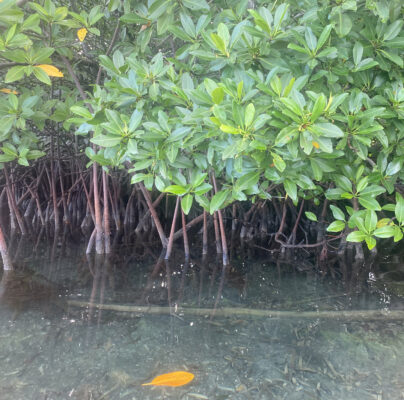
I was underwater, snorkeling at last in good mangroves in Belize. It took a bit of doing. I’ve looked at the mangroves underwater a few times in an area near the main pier of Placencia, but these were heavily disturbed and all sorts of floating trash ended up there. I wanted to see some pristine mangroves finally. And I hoped I could photograph a sea cucumber for my Parisian friend Chantel Conand, a world-renowned expert of this taxa, just for the fun of it.
That’s where my Belizean friend Jason Williams came in. It was a slow day for his normal tourist excursions from Placencia to his home of Monkey River and the weather was finally good for snorkeling. He agreed to take me out alone to a mangrove island offshore, un-silted from the recent rains that muddied the inshore mangrove forests. But offshore, the water was clear. He located a little cove surrounded by mangroves on an offshore cay and watched me alertly from his boat as I swam around the mangrove fringe. I had my iPhone and new underwater casing with me and was eager to try it at last. But for no apparent reason, it did not take photos underwater. (Postscript: I now know that the touchscreen doesn’t work underwater and you have to click the volume controls instead. Too little knowledge, too late.)

I sadly gave my camera back to Jason on the boat and continued to explore without this impediment in my hand. I happily floated with porkfish, mangrove snappers, and schools of tiny neon blue fish that parted when I swam through them. But then, venturing further, I found my old nemesis, Cassiopeia xamachana, the “upside down jellyfish.” I spent two years of my life at Miami Seaquarium scooping tons of these slimy stinging creatures into a tank holding our three precious young leatherback sea turtles, the only ones ever kept alive in captivity at that time. Leatherbacks cannot digest fish, only jellyfish, and, at Miami Seaquarium we had a trove of these in the mangroves behind the “Flipper Stadium.” I developed a painful sensitivity to the jellyfish and was always suffering from their stings, no matter how careful I was. And never, ever would I even dream of snorkeling with these noxious creatures. But here I was …
I cruised at a safe distance (I thought) above them, and admired their feeding arms, some with vivid blue tendrils, some without? Maybe a difference in the sexes? I noticed other structures on the substrate, almost flower-like. What were these? It was all interesting, but even from a distance above those damned jellyfish I felt a stinging sensation on my skin. It was only hours later on the Internet I learned much more. Those flower-looking organisms scattered among the jellyfish were actually polyps, another stage in their life cycle. And, scientists have now discovered that the slime of the medusa stage of these jellyfish (the stage I handled to feed the turtles) contained thousands of little independent stinging cells that travel on their own in the seawater to sting anything threatening them. Like self-propelled missiles, these little stinging bits had their own agenda apart from their host. And just swimming above them I was being attacked by their stings.

Enough of this. I climbed back into Jason’s boat, and we zoomed back to Placencia. But then magic happened! We were in the midst of a large pod of dolphins! We slowed the boat and they frolicked around us, some jumping into the air in their trademark bows, others circling around us, even lifting their heads above water to look at us too. Jason and I both got our cameras into action and we tried to capture this impromptu show. But no photos or videos could convey the thrill of seeing them playing in the water around us, seemingly enjoying the encounter as much as we did. To my amazement, this was a mixed pod of two species of dolphins, the bottlenose dolphins I am very familiar with, but also a bunch of spotted dolphins intermixed with them. It was a first for me, seeing this new cetacean species, a thrill beyond thrills. And a bit further along we stopped again to watch a manatee, always fun too.

On the way back to Placencia we circled another cay, designed entirely for Norwegian Cruise Line passengers and enhanced with tons of dredged sand and landscaping. Here visitors from the ship can swing on a zipline from a phony lighthouse, bask in the sun in a row of hundreds of lounge chairs and feel like they are in Belize, but not really.
To really be in Belize you have to be surrounded by dolphins, snorkel among the stinging jellyfish and share fun and laughter with Belizeans like Jason. Now that is the real deal!
Pat Foster-Turley, Ph.D., is a zoologist on Amelia Island. She welcomes your nature questions and observations. [email protected]

Nice.
Thanks for telling us about the real Belize. So interesting as always.